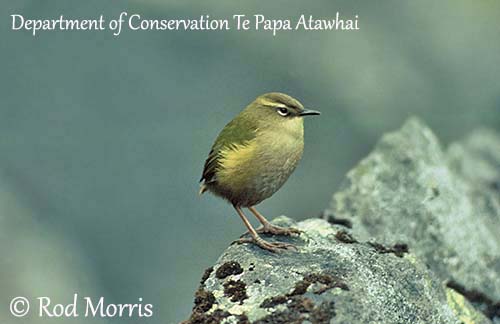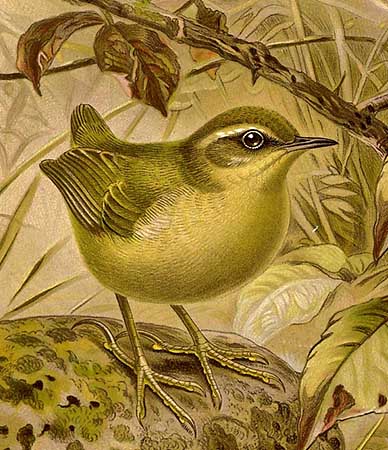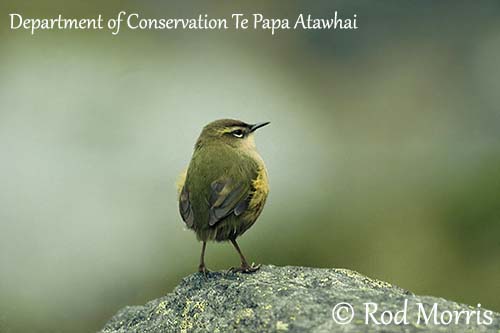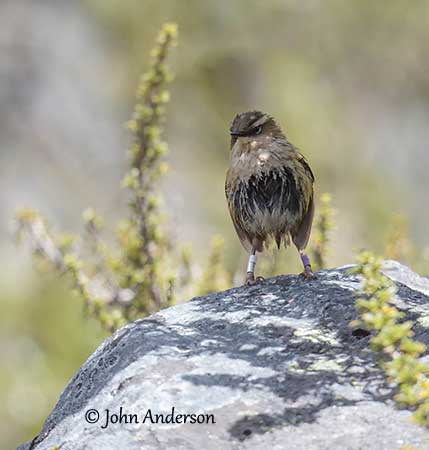
Fr: Xénique des rochers
Maori: Pīwauwau
Ang: New Zealand Rockwren - South Island Wren
All: Felsschlüpfer
Esp: Acantisita Roquero
Ita: Scricciolo di roccia della Nuova Zelanda
Nd: Rotswinterkoning
Sd: Bergsklippsmyg
Photographer:
Rod Morris
Courtesy of Department of Conservation Te Papa Atawhai, 1975
Department of Conservation
John Anderson
John Anderson Photo Galleries
Illustrators:
William Lawry Buller (1838-1906)
« A History of the Birds of New Zealand, 2nd Edition »
John Gerrard Keulemans (1842-1912)
(Illustration used by Walter Lawry Buller in « A History of the Birds of New Zealand” 1st edition. Published 1873.
Text by Nicole Bouglouan
Sources:
HANDBOOK OF THE BIRDS OF THE WORLD Vol 9 - by Josep del Hoyo - Andrew Elliot - David Christie - Lynx Edicions - ISBN: 8487334695
BirdLife International (BirdLife International)
New Zealand birds and birding (Narena Olliver)
New Zealand bird status between 2008 and 2012
Te Ara – The Encyclopedia of New Zealand
Wikipedia, the free encyclopaedia
Wildlife Extra, the web's wildlife magazine
Page Family Acanthisittidae
Page Passeriformes Order
DESCRIPTION OF THE BIRD:
Biometrics:
Length: 10 cm
Weight: M: 16 g – F: 20 g
The New Zealand Rockwren has short tail and rounded wings, long legs and toes.
The adult male has olive-brown head and neck, and a conspicuous white supercilium, bordered by black stripes above and below.
The upperparts are olive-green, including the wings where we can see a black patch at bend of folded wings. There is a row of pale spots on the lower back well visible on a perched bird. This row is formed by the pale tips of the secondaries. The very short tail is dull olive-brown.
On the underparts, chin and throat are whitish, whereas rest of underparts is pale grey or creamy-white. Flanks are yellowish.
The birds of the southern part of the range have brighter and greener head and upperparts, and brighter yellow flanks.
The slender bill is blackish-brown. The eyes are dark brown with white crescent below the eye. Legs and feet are pale pinkish-brown, with long hind toe and claw.

The female is duller and slightly paler, mostly dull olive-brown.
The juvenile resembles adult, but it has dark grey bill with orange base of lower mandible, and darker legs and feet.
RANGE:
The New Zealand Rockwren is found in mountain areas on South Island, New Zealand. This species is patchily distributed in alpine and subalpine areas. It is most common within the Southern Alps, but some localised populations can be found further north. They are less abundant in the Eyre Mountains and parts of inland Canterbury and the Victoria Range.
HABITAT:
The New Zealand Rockwren frequents open alpine areas between 900 and 2500 metres of elevation. It can be found in rocky alpine and subalpine habitats, under large boulders, at the foot of screes and rock falls, often in very exposed situations and areas with prolonged snow cover, and usually near water.
In Fiordland, it occurs at lower elevation, around 900 metres, in subalpine scrub.
CALLS AND SONGS: SOUNDS BY XENO-CANTO
The New Zealand Rockwren gives high-pitched, thin three-note calls “tzee-tzit-tzit” and a short “zipt”. We can also hear a whirring call.
Like the Rifleman, it has limited repertoire of short, simple calls and trills, all high-pitched sounds.
BEHAVIOUR IN THE WILD:
The New Zealand Rockwren feeds on various invertebrates such as moths and their larvae, beetles, flies, caterpillars, caddisflies (Trichoptera) and spiders. It occasionally takes grass seeds and fruit from Gaultheria and Coprosma plant species.

William Lawry Buller
(1838-1906)
It gleans preys from low vegetation and from rocky crevices among boulders. It uses its feet to pry apart vegetation, but also to grip flexible shoots. This small bird often disappears down holes or enters narrow spaces while foraging.
During winter, when the snow covers rocks and scrub, it moves about in gaps or crevices beneath the snow.
It occasionally catches flying insects by aerial sallies, but mainly in warm weather. The larger preys such as grasshoppers are beaten against hard surface before being eaten.
Berries and seeds are mostly taken during the cooler season. It may sometimes drinks nectar from flowers, especially those of New Zealand flax (Phormium).
They usually forage in pairs or in small groups of 6-8 individuals, probably family groups. It is rarely seen foraging alone.
The New Zealand Rockwren is monogamous with long-term pair-bonds. This species has not been observed to breed co-operatively like the Rifleman.
They have a short breeding season of less than four months, due to the high-altitude climate in which this species is living.
The male performs courtship feeding to female, but the female also sometimes feeds her mate. Courtship displays are very simple as both sexes are living together all the year. The male guards the female before and during the laying period.
Usually, the female selects the nest-site. When she presents nest materials to the male, she performs bobbing and wing-flicking movements. She demonstrates her chosen nest-site by some displays such as wing-spreading and wing-vibrating, accompanied by much calling.

The New Zealand Rockwren is thought to remain in its subalpine habitats all year round, including during the austral winter. Some reports suggest that the species is surviving in pockets of space between snow-covered rocks and plants, or by entering a state of torpor for short periods. But more information and observations are necessary to confirm these theories.
While feeding, the New Zealand Rockwren hops and buzzes about on short rounded wings. It usually flies low, 2-3 metres above the ground, and rarely over more than 30 metres. It moves quickly among boulders, and on the ground, it bobs up and down while flicking its wings.
REPRODUCTION OF THIS SPECIES:
The New Zealand Rockwren breeds in spring and summer, from September to January.
Both sexes build a fully enclosed bulky nest with side tunnel entrance in natural cavity, usually on or near the ground, or in crevice between rocks, or among roots, or they excavate a nest-hole in the soil. The inner part of the nest is covered with a thick lining of feathers. The nest is made with dry grass, moss, pieces of leaves and tussock.

John Gerrard Keulemans
(1842-1912)
The female lays 2-5 cream-coloured eggs and both adults incubate during about 19-21 days. The chicks are fed by parents. When one adult leaves the nest, it covers the eggs and blocks the entrance with feathers in order to avoid heat loss. The chicks fledge about 21-26 days after hatching, and they are independent at 2-3 weeks old.
This species produces a single brood during the short breeding season, but there is a replacement clutch if the first one is lost.
PROTECTION / THREATS / STATUS:
The New Zealand Rockwren is threatened by introduced mice and stoats which take eggs and chicks at nest. The high-altitude habitat of this species is threatened by global warming, involving an increase of predation.
The species is listed as Naturally Endangered in New Zealand since 2013, and globally, it is classified as Vulnerable with a population estimated at less than 10,000 individuals, and this population is still declining.

New Zealand Rockwren or South Island Wren
Xenicus gilviventris
Passeriformes Order – Acanthisittidae Family
INTRODUCTION:
The New Zealand Rockwren is mainly a terrestrial species endemic to New Zealand. This species usually frequents harsh upland environment where its long legs set back on the body, combined with long toes and claws, help the bird to move within its rocky habitat. It moves about by hopping and progresses on the ground with a bouncing gait and both feet moving together.
The New Zealand Rockwren is listed as Vulnerable. It is threatened by the introduced mammalian predators, especially mice and stoats. Conservation actions are underway with the translocation of several birds to predator-free islands, after the unsuccessful 2005 attempt on Anchor Island in Fiordland. However, other birds were transferred successfully to Secretary Island in Fiordland in 2008/2010.
